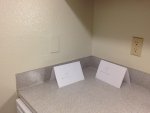- Location
- Placerville, CA, USA
- Occupation
- Retired PV System Designer
I will make a stab at redescribing it, then I may be forced to try a drawing.I agree :lol:
Unfortunately, I can't follow what you're trying to describe at all :happysad:
1. To set a reference point, what is your answer to the following hypothetical:
I have a 12' long countertop which runs along one wall of the kitchen and terminates at the walls on either side of that run. The countertop is 32 inches deep.
Does the code require the installation of a receptacle in each of the side walls, regardless of where I place the outlets along the back wall?
I can see arguments for both answer, but I think that the stronger argument is that since the outlets along the back wall are sufficient to cover the full depth of the 32" counter, there is no justification for requiring an extra outlet in the side wall at each end.
2. Now consider a different arrangement:
There is a 32" deep counter running along two 10' kitchen walls which meet at right angles. The two ends are at doorways so that there is no "side" wall to complicate things. There is no sink or range in or near the corner to trigger the Figure 210.52(C)(1) exceptions.
Since the counter "covers" 32 inches of each of the corner walls, do I need to put an outlet within 24" of the corner on both of the corner walls? And incidentally, can I consider the wall length to be continuous around the corner so that a receptacle 6" from the corner of the left wall is considered to cover the next 18" from the corner along the right wall?
One answer is that I have to look at the wall as if it were a continuous line 20' line and install with no more than a 48 inch gap anywhere along that line and no more than 24" at either end.
The second answer is that I have to look at the two ten foot lines and meet the 48" requirement for each of them separately. This could require at least one more receptacle.
The third answer is that a single receptacle less than 24" from the corner on either wall covers the entire area of the countertop defined by the 32" by 32" square one of whose corners is the inside corner of the countertop?
The first answer seems to me to be the most justifiable if you answered question 1 with yes, requiring side wall receptacles, while the third answer is the most justifiable if you answered no to question 1.
If you answered yes to question 1, the OP needs to have a second receptacle in the right wall.
If you answered no to question 1, the OP would not need to add a second receptacle if it were not for that pesky 3" extension.
With the 3" extension, the answer to the OP's question would then depend on your answer to question 2.
And even if you chose answer three to question two, the issue would still revolve around whether you start a new counter segment for the 3" extension, making it less than 12" of wall space or consider the code to require one receptacle in the 27" span because only 24" of it was covered.


